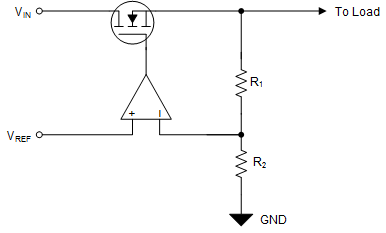SBVS446A August 2023 – January 2024 TPS7A53B
PRODUCTION DATA
- 1
- 1 Features
- 2 Applications
- 3 Description
- 4 Pin Configuration and Functions
- 5 Specifications
- 6 Detailed Description
-
7 Application and Implementation
- 7.1
Application Information
- 7.1.1 Recommended Capacitor Types
- 7.1.2 Soft-Start and Inrush Current
- 7.1.3 Optimizing Noise and PSRR
- 7.1.4 Charge Pump Noise
- 7.1.5 Current Sharing
- 7.1.6 Adjustable Operation
- 7.1.7 Power-Good Operation
- 7.1.8 Undervoltage Lockout (UVLO) Operation
- 7.1.9 Dropout Voltage (VDO)
- 7.1.10 Device Behavior During Transition From Dropout Into Regulation
- 7.1.11 Load Transient Response
- 7.1.12 Reverse Current Protection Considerations
- 7.1.13 Power Dissipation (PD)
- 7.1.14 Estimating Junction Temperature
- 7.1.15 TPS7A53EVM Thermal Analysis
- 7.2 Typical Application
- 7.3 Power Supply Recommendations
- 7.4 Layout
- 7.1
Application Information
- 8 Device and Documentation Support
- 9 Revision History
- 10Mechanical, Packaging, and Orderable Information
Package Options
Mechanical Data (Package|Pins)
- RPS|12
Thermal pad, mechanical data (Package|Pins)
Orderable Information
6.3.1.1 DC Regulation
A low-dropout regulator (LDO) functions as a class-B amplifier, as shown in Figure 6-1, in which the input signal is the internal reference voltage (VREF). VREF is designed to have very low bandwidth at the input to the error amplifier by using a low-pass filter (VNR/SS).
As such, the reference can be considered as a pure dc input signal. The low output impedance of an LDO comes from the combination of the output capacitor and pass transistor. The pass transistor also presents a high input impedance to the source voltage when operating as a current source. A positive LDO can only source current because of the class-B architecture.
This device achieves a maximum of 0.75% output voltage accuracy primarily because of the high-precision band-gap voltage (VBG) that creates VREF. The low dropout voltage (VDO) reduces the thermal power dissipation required by the device to regulate the output voltage at a given current level, thereby improving system efficiency. These features combine to make this device a good approximation of an optimal voltage source.
